
USS Talladega (APA/LPA-208) was a Haskell-class attack transport of the US Navy. She was of the VC2-S-AP5 Victory ship design type. Talladega was named for Talladega County, Alabama.

USS Currier (DE-700) was a Buckley-class destroyer escort in service with the United States Navy from 1944 to 1960. She was sunk as a target in 1967.

USS Skagit (AKA-105/LKA-105) was a Tolland-class attack cargo ship in service with the United States Navy from 1945 to 1949 and from 1950 to 1969. She was scrapped in 1974.

USS Almaack (AKA-10) was an Almaack class attack cargo ship named after Almaack, a star system in the constellation Andromeda. She served as a commissioned ship for 4 years and 11 months.

USS Samaritan (AH-10) was a hospital ship that served with the US Navy in World War II. Prior to that, she served as a US Navy transport ship under the name USS Chaumont (AP-5).
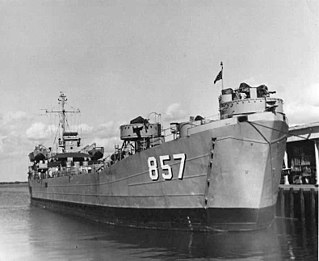
USS King County (LST-857) was an LST-542-class tank landing ship built for the United States Navy during World War II. Named after counties in Texas and Washington, she was the only U.S. Naval vessel to bear the name.
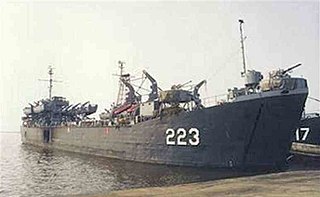
USS Iron County (LST-840) was an LST-542-class tank landing ship built for the United States Navy during World War II. Named after counties in Michigan, Missouri, Utah, and Wisconsin, she was the only U.S. Naval vessel to bear the name.

USS Kemper County (LST-854) was an LST-542-class tank landing ship built for the United States Navy during World War II. Named after Kemper County, Mississippi, she was the only U.S. Naval vessel to bear the name.

USS Denebola (AF-56) was a Denebola-class stores ship acquired by the U.S. Navy. She was built as SS Hibbing Victory as a type VC2-S-AP2 Victory ship built by Oregon Shipbuilding Corporation of Portland, Oregon, under a Maritime Commission. The Maritime Administration cargo ship was the 113th ship built. Its keel was laid on 2 May 1944. The ship was christened on 30 June 1944. She was built at the Oregon Shipbuilding yards in just 59 days, under the Emergency Shipbuilding program for World War II. The 10,600-ton ship was constructed for the Maritime Commission. She was operated by the (Pacific-Atlantic SS Company under the United States Merchant Marine act for the War Shipping Administration. The other two ships in her class were USS Regulus and USNS Perseus. USS Denebola's task was to carry stores, refrigerated items, and equipment to ships in the fleet, and to remote stations and staging areas.

USS James O'Hara (APA-90) was a Frederick Funston-class attack transport that served with the US Navy during World War II and later in the Korean War. The ship was named after a Continental Army officer who fought in the Revolutionary War and who later became Quartermaster General of the US Army.
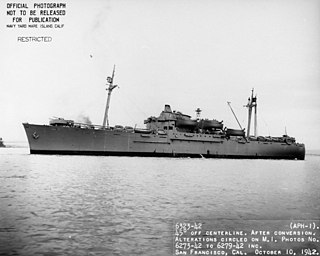
USS Tryon (APH-1) was laid down as SS Alcoa Courier on 26 March 1941, by the Moore Dry Dock Company, Oakland, California and launched on 21 October 1941 sponsored by Mrs. Roy G. Hunt. After the attack on Pearl Harbor, she was designated for U.S. Navy use and assigned the name Comfort in June 1942. Comfort was renamed Tryon on 13 August 1942, acquired by the U.S. Navy on 29 September 1942, and commissioned on 30 September 1942.

USS Menard (APA-201) was a Haskell-class attack transport that saw service with the US Navy in World War II, the Korean War and Vietnam War.
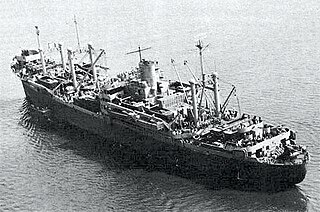
USS Warren (APA-53) was a Sumter-class attack transport that served with the US Navy during World War II. She was named for Founding Father and American Revolutionary War hero Joseph Warren.

USS George Clymer (APA-27) was an Arthur Middleton-class attack transport that saw service with the US Navy in four wars - World War II, the Chinese Civil War, the Korean War and the Vietnam War. It was named after United States Founding Father George Clymer.
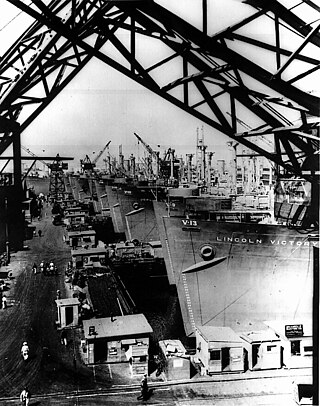
The SS Joplin Victory was the 12th Victory ship built during World War II under the Emergency Shipbuilding program. She was launched by the California Shipbuilding Company on April 25, 1944 and completed on June 15, 1944. The ship's United States Maritime Commission designation was VC2-S-AP3, hull number 12 (V-12). The 10,500-ton Victory ships were designed to replace the earlier Liberty Ships. Liberty ships were designed to be used just for World War II. Victory ships were designed to last longer and serve the US Navy after the war. The Victory ship differed from a Liberty ship in that they were: faster, longer and wider, taller, had a thinner stack set farther toward the superstructure and had a long raised forecastle.

The SS Bluefield Victory was the 16th Victory ship built during World War II under the Emergency Shipbuilding program. She was launched by the California Shipbuilding Company on May 9, 1944, and completed on June 30, 1944. The ship’s United States Maritime Commission designation was VC2- S- AP3, hull number 15 (V-15). SS Bluefield Victory served in the Pacific Ocean during World War II and was operated by the Mississippi Shipping Company. The 10,500-ton Victory ships were designed to replace the earlier Liberty Ships. Liberty ships were designed to be used just for World War II. Victory ships were designed to last longer and serve the US Navy after the war. The Victory ship differed from a Liberty ship in that they were: faster, longer and wider, taller, had a thinner stack set farther toward the superstructure, and had a long raised forecastle.

SS Frontenac Victory was a Victory ship built for the United States War Shipping Administration late in World War II under the Emergency Shipbuilding program. It saw service in the European Theater of Operations in the Atlantic Ocean during 1945, and in the immediate post-war period. SS Frontenac Victory was part of the series of Victory ships named after cities; this particular ship was named after the city of Frontenac, Missouri. It was a type VC2-S-AP2/WSAT cargo ship with the U.S. Maritime Commission (MARCOM), "Victory" (MCV) hull number 625, shipyard number 1597, and built by Bethlehem Shipbuilding Corporation in Baltimore, Maryland.

SS Luxembourg Victory was a Victory ship built for the United States during World War II. She was launched by the Oregon Shipbuilding Corporation on February 28, 1944, and was completed on April 5, 1944. The ship's US Maritime Commission designation was VC2-S-AP3, hull number 90 (V-90). She was built in 101 days under the Emergency Shipbuilding program. The Maritime Commission turned her over to a civilian contractor, the Lykes Brothers SS Company, for operation until the end of World War II hostilities. She was operated under the US Merchant Marine Act for the War Shipping Administration.

The SS Minot Victory was a Victory ship built during World War II under the Emergency Shipbuilding program. She was laid down and launched by the Oregon Shipbuilding Corporation, and completed on February 1, 1945. The ship's United States Maritime Commission designation was VC2-S-AP3 and hull number 149 (1203). The Maritime Commission turned it over for merchant navy operation to a civilian contractor, the Isthmian Steamship Company under the United States Merchant Marine act for the War Shipping Administration. She was named after Minot, Maine and Minot, North Dakota.

The SS Berea Victory (MCV-734) was a type VC2-S-AP2 Victory-class cargo ship built for the United States during World War II. The ship was built as part of the Emergency Shipbuilding program by Permanente Metals Corporation in Yard 2 of the Richmond Shipyards in Richmond, California. Launched on 3 March 1945, the Berea Victory delivered supplies for the Pacific War.

















